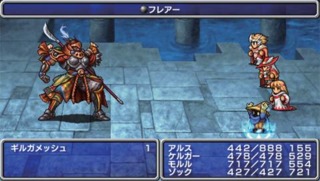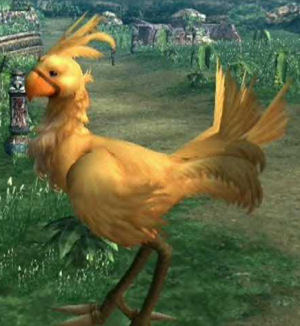Navigation
Sub-Franchises:
Final Fantasy Tactics | Final Fantasy Crystal Chronicles | Chocobo | Final Fantasy Fables | Compilation of Final Fantasy VII | Ivalice Alliance | Fabula Nova Crystallis | Dissidia
Related Franchises:
Kingdom Hearts | Itadaki Street | Dragon Quest | Mana | Chrono | SaGa
Overview
 FFI 20th Anniversary Edition for the PSP
FFI 20th Anniversary Edition for the PSPFinal Fantasy is Square Enix's longest running and most popular role-playing franchise. First premiering on December 18, 1987 with the original Final Fantasy, it has only increased in popularity over the last 35 years. The first Final Fantasy was created by Hironobu Sakaguchi and was planned as a last-ditch attempt at success in the game industry (hence the title). Inspired by Enix's Dragon Warrior, he took the last of Square's money and developed the game. It sold 400,000 units, kicking off what has become one of the best-selling video game franchises in history. This series has had several spin-offs, some of which are Final Fantasy Adventure (which went on to become the Mana series), Final Fantasy Tactics, a series of turn-based strategy RPGs, and even several games starring the Final Fantasy mascot, the cute, ostrich-like chocobo. Additionally, the first few games of Squaresoft's SaGa series were given "Final Fantasy Legend" titles when they were released in North America because of Final Fantasy's recognizable name.
 A Chocobo
A ChocoboSince its inception, the series has branched out into portable games, action spin-offs, a massively multiplayer online role-playing game, and even games for mobile phones. Originally, each new Final Fantasy game introduced to players an entirely new world, storyline, and set of characters. However, since Final Fantasy II the games have each shared a number of motifs that fans have come to look for. For instance, there has always been a character named Cid, who is usually connected to flight, whether as a pilot or engineer (though he has also been known as a political figure from time to time). Chocobos appear frequently in most Final Fantasy stories, and are usually used as mounts for the player. The teddy bear-like Moogle is also very common to Final Fantasy games. Cactuars often appear as enemies in Final Fantasy games, but have been known to show up in doll-like form.
 Final Fantasy IV The Complete Collection
Final Fantasy IV The Complete CollectionFinal Fantasy IV was the second game to be released outside of Japan and introduced many key elements that would stick with the future titles of the series: Save Points, Active Time Battle System, theatrical cutscenes, character leitmotifs, etc. This game was known as Final Fantasy II in North America and the forthcoming Final Fantasy VI was renamed to Final Fantasy III in North America. It wasn't until Final Fantasy VII that the series retro-actively changed it's chronological naming for the North American releases.
More recently, Square Enix has begun to extend the most popular Final Fantasy games beyond their initial release. Characters from numerous Final Fantasy games have made appearances in games like Kingdom Hearts, Ehrgeiz, and Dissidia. Several specific main series games have also received direct sequels or spin-offs which often occupy different genres. Final Fantasy X saw a sequel, the appropriately titled Final Fantasy X-2, which directly continued and concluded the original game's storyline.
The wildly popular Final Fantasy VII has seen numerous related releases, including the PSP action RPG Crisis Core, the PlayStation 2 third-person action game Dirge of Cerberus, a mobile game released only in Japan called Before Crisis, and in 2020, after much clamoring for it from fans, Final Fantasy VII Remake was released for PlayStation 4.
In a similar vein, Final Fantasy XIII had a trilogy of games released within the same world, include Final Fantasy XIII-2, and Lightning Returns: Final Fantasy XIII.
Final Fantasy I
Main article: Final Fantasy
Released in 1987, the original NES/Famicom Final Fantasy introduced many of the common elements of console role-playing and helped popularize the genre in the late 1980s. Beyond the random battles and experience points typical to almost all RPGs, the first Final Fantasy laid down some aspects of the Final Fantasy franchise in particular that persisted throughout numerous subsequent installments. The story takes place in a world where four elemental orbs control the forces of nature--earth, fire, wind, and water--but the orbs turn black and the forces go out of control. Four warriors come together to journey across the land in a quest to vanquish the monsters that have overrun the land and restore the orbs to their former splendor, saving the world form peril. Many Final Fantasy games have relied on these four elements as an essential device in their storylines.
Other Mainline Final Fantasy Games
 An FMV sequence from Final Fantasy X, the first PS2 entry in the series.
An FMV sequence from Final Fantasy X, the first PS2 entry in the series.Some of the most important games in the franchise have added specific new mechanics or storytelling techniques.
- Final Fantasy II introduced a main cast of characters that were unique to the story, Cid, and chocobos.
- Final Fantasy III implemented the job system (which lets party members learn special abilities associated with specific jobs), summoned monster attacks, and introduced the moogle.
- Final Fantasy IV implemented Save Points where characters could save their progress and use Tents or Cabins to heal and débuted the " active time battle" system, which causes battles to proceed in a quasi-real-time fashion. Many other RPGs have adopted some form of the ATB system.
- Final Fantasy IV: The After Years is the sequel that takes place over a decade after the events of Final Fantasy IV. This game uses a combination attack system similar to Chrono Trigger.
- Final Fantasy V refined the job system from Final Fantasy III.
- Final Fantasy VI was the last of the three SNES Final Fantasy games. It introduced Magicite that could be equipped to characters so that they may learn Magic despite their Job Class.
- Final Fantasy VII was the first Final Fantasy released on PlayStation, was the first game to use 3D character models, pre-rendered backgrounds, and lavishly produced CG movies.
- Final Fantasy VIII took the series in a radical new direction, essentially eliminating the need for shops, and introducing the Junction system.
- Final Fantasy IX was a "return to form" for the series, going back to series roots, taking place in a medieval inspired world, bringing back the more classic jobs and character designs as well as many more elements of the Nintendo era Final Fantasy games.
- Final Fantasy X introduced fully 3D real-time backgrounds and character voice acting.
- Final Fantasy X-2 was the first direct sequel in the series, taking place two years after the events of Final Fantasy X.
- Final Fantasy XI was the first MMORPG in the series, and still enjoys a modest player base today. It is the first Final Fantasy to appear on a Microsoft console.
- Final Fantasy XII is, so far, the only main series game to take place in a previously established world (that of Final Fantasy Tactics' Ivalice).
- Final Fantasy XIII is the first single-player focused entry to see release on a Microsoft console, and the first Final Fantasy to appear on the PlayStation 3.
- Final Fantasy XIII-2 is one of the few direct sequels in the franchise.
- Lightning Returns: Final Fantasy XIII is the second and final direct sequel in the XIII series, and the first time a direct Final Fantasy sequel has received a direct sequel.
- Final Fantasy XIV is the successor to Final Fantasy XI as the second massively multiplayer title in the series. Following a ruinous launch, the game was completely rebuilt under Naoki Yoshida, where it would go onto become one of the most popular MMOs of all time, alongside receiving several expansions.
- Final Fantasy XV is the series' first mainline entry on PlayStation 4 and Xbox One, and was originally announced as Final Fantasy Versus XIII.
- Final Fantasy XVI is an upcoming mainline entry for PlayStation 5, produced by Final Fantasy XIV producer/director Naoki Yoshida.
Log in to comment